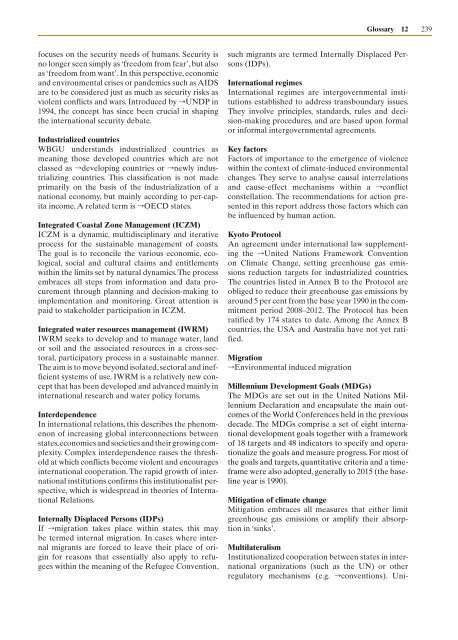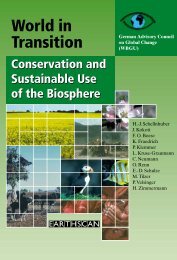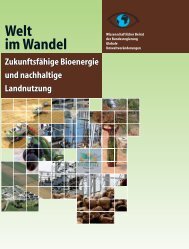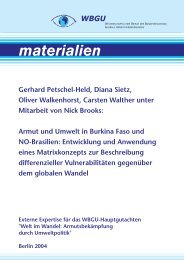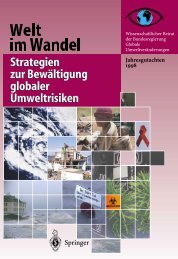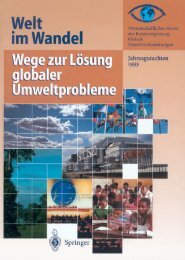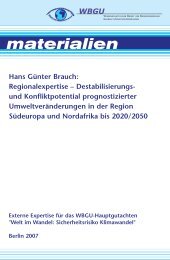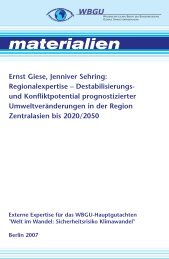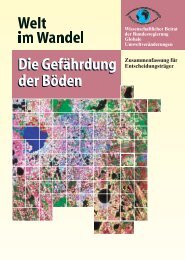World in Transition: Climate Change as a Security Risk - WBGU
World in Transition: Climate Change as a Security Risk - WBGU
World in Transition: Climate Change as a Security Risk - WBGU
You also want an ePaper? Increase the reach of your titles
YUMPU automatically turns print PDFs into web optimized ePapers that Google loves.
focuses on the security needs of humans. <strong>Security</strong> is<br />
no longer seen simply <strong>as</strong> ‘freedom from fear’, but also<br />
<strong>as</strong> ‘freedom from want’. In this perspective, economic<br />
and environmental crises or pandemics such <strong>as</strong> AIDS<br />
are to be considered just <strong>as</strong> much <strong>as</strong> security risks <strong>as</strong><br />
violent conflicts and wars. Introduced by ’UNDP <strong>in</strong><br />
1994, the concept h<strong>as</strong> s<strong>in</strong>ce been crucial <strong>in</strong> shap<strong>in</strong>g<br />
the <strong>in</strong>ternational security debate.<br />
Industrialized countries<br />
<strong>WBGU</strong> understands <strong>in</strong>dustrialized countries <strong>as</strong><br />
mean<strong>in</strong>g those developed countries which are not<br />
cl<strong>as</strong>sed <strong>as</strong> ’develop<strong>in</strong>g countries or ’newly <strong>in</strong>dustrializ<strong>in</strong>g<br />
countries. This cl<strong>as</strong>sification is not made<br />
primarily on the b<strong>as</strong>is of the <strong>in</strong>dustrialization of a<br />
national economy, but ma<strong>in</strong>ly accord<strong>in</strong>g to per-capita<br />
<strong>in</strong>come. A related term is ’OECD states.<br />
Integrated Co<strong>as</strong>tal Zone Management (ICZM)<br />
ICZM is a dynamic, multidiscipl<strong>in</strong>ary and iterative<br />
process for the susta<strong>in</strong>able management of co<strong>as</strong>ts.<br />
The goal is to reconcile the various economic, ecological,<br />
social and cultural claims and entitlements<br />
with<strong>in</strong> the limits set by natural dynamics. The process<br />
embraces all steps from <strong>in</strong>formation and data procurement<br />
through plann<strong>in</strong>g and decision-mak<strong>in</strong>g to<br />
implementation and monitor<strong>in</strong>g. Great attention is<br />
paid to stakeholder participation <strong>in</strong> ICZM.<br />
Integrated water resources management (IWRM)<br />
IWRM seeks to develop and to manage water, land<br />
or soil and the <strong>as</strong>sociated resources <strong>in</strong> a cross-sectoral,<br />
participatory process <strong>in</strong> a susta<strong>in</strong>able manner.<br />
The aim is to move beyond isolated, sectoral and <strong>in</strong>efficient<br />
systems of use. IWRM is a relatively new concept<br />
that h<strong>as</strong> been developed and advanced ma<strong>in</strong>ly <strong>in</strong><br />
<strong>in</strong>ternational research and water policy forums.<br />
Interdependence<br />
In <strong>in</strong>ternational relations, this describes the phenomenon<br />
of <strong>in</strong>cre<strong>as</strong><strong>in</strong>g global <strong>in</strong>terconnections between<br />
states, economies and societies and their grow<strong>in</strong>g complexity.<br />
Complex <strong>in</strong>terdependence raises the threshold<br />
at which conflicts become violent and encourages<br />
<strong>in</strong>ternational cooperation. The rapid growth of <strong>in</strong>ternational<br />
<strong>in</strong>stitutions confirms this <strong>in</strong>stitutionalist perspective,<br />
which is widespread <strong>in</strong> theories of International<br />
Relations.<br />
Internally Displaced Persons (IDPs)<br />
If ’migration takes place with<strong>in</strong> states, this may<br />
be termed <strong>in</strong>ternal migration. In c<strong>as</strong>es where <strong>in</strong>ternal<br />
migrants are forced to leave their place of orig<strong>in</strong><br />
for re<strong>as</strong>ons that essentially also apply to refugees<br />
with<strong>in</strong> the mean<strong>in</strong>g of the Refugee Convention,<br />
Glossary 12<br />
such migrants are termed Internally Displaced Persons<br />
(IDPs).<br />
International regimes<br />
International regimes are <strong>in</strong>tergovernmental <strong>in</strong>stitutions<br />
established to address transboundary issues.<br />
They <strong>in</strong>volve pr<strong>in</strong>ciples, standards, rules and decision-mak<strong>in</strong>g<br />
procedures, and are b<strong>as</strong>ed upon formal<br />
or <strong>in</strong>formal <strong>in</strong>tergovernmental agreements.<br />
Key factors<br />
Factors of importance to the emergence of violence<br />
with<strong>in</strong> the context of climate-<strong>in</strong>duced environmental<br />
changes. They serve to analyse causal <strong>in</strong>terrelations<br />
and cause-effect mechanisms with<strong>in</strong> a ’conflict<br />
constellation. The recommendations for action presented<br />
<strong>in</strong> this report address those factors which can<br />
be <strong>in</strong>fluenced by human action.<br />
Kyoto Protocol<br />
An agreement under <strong>in</strong>ternational law supplement<strong>in</strong>g<br />
the ’United Nations Framework Convention<br />
on <strong>Climate</strong> <strong>Change</strong>, sett<strong>in</strong>g greenhouse g<strong>as</strong> emissions<br />
reduction targets for <strong>in</strong>dustrialized countries.<br />
The countries listed <strong>in</strong> Annex B to the Protocol are<br />
obliged to reduce their greenhouse g<strong>as</strong> emissions by<br />
around 5 per cent from the b<strong>as</strong>e year 1990 <strong>in</strong> the commitment<br />
period 2008–2012. The Protocol h<strong>as</strong> been<br />
ratified by 174 states to date. Among the Annex B<br />
countries, the USA and Australia have not yet ratified.<br />
Migration<br />
’Environmental <strong>in</strong>duced migration<br />
Millennium Development Goals (MDGs)<br />
The MDGs are set out <strong>in</strong> the United Nations Millennium<br />
Declaration and encapsulate the ma<strong>in</strong> outcomes<br />
of the <strong>World</strong> Conferences held <strong>in</strong> the previous<br />
decade. The MDGs comprise a set of eight <strong>in</strong>ternational<br />
development goals together with a framework<br />
of 18 targets and 48 <strong>in</strong>dicators to specify and operationalize<br />
the goals and me<strong>as</strong>ure progress. For most of<br />
the goals and targets, quantitative criteria and a timeframe<br />
were also adopted, generally to 2015 (the b<strong>as</strong>el<strong>in</strong>e<br />
year is 1990).<br />
Mitigation of climate change<br />
Mitigation embraces all me<strong>as</strong>ures that either limit<br />
greenhouse g<strong>as</strong> emissions or amplify their absorption<br />
<strong>in</strong> ‘s<strong>in</strong>ks’.<br />
Multilateralism<br />
Institutionalized cooperation between states <strong>in</strong> <strong>in</strong>ternational<br />
organizations (such <strong>as</strong> the UN) or other<br />
regulatory mechanisms (e.g. ’conventions). Uni-<br />
239


